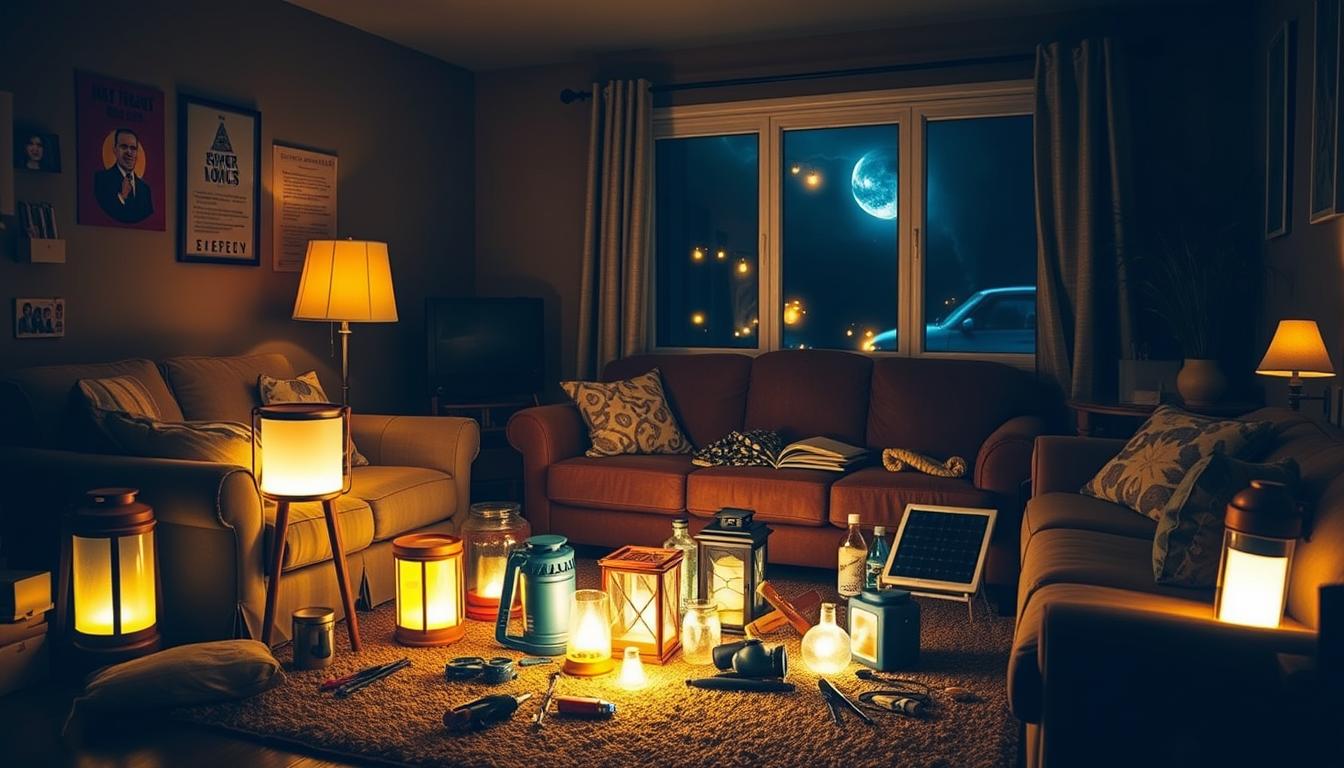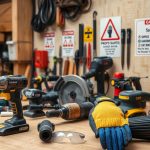Having a reliable emergency lighting system is key for homeowners, mainly during power outages. Backup lights and emergency systems help keep you safe and comfortable. A DIY system is a budget-friendly way to prepare for emergencies, giving you peace of mind.
Emergency lighting is vital for any emergency plan. It’s simple to set up and keep running. Adding backup lights and systems to your home makes it safe and cozy, even when the power goes out.
Introduction to Emergency Lighting
Emergency lighting, backup lights, and systems offer steady light when the power fails. This lets you move around your home safely and comfortably. By choosing a DIY system, you safeguard yourself and your family from power outage dangers.
Key Takeaways
- Emergency lighting is a crucial component of any emergency preparedness plan
- Backup lights and emergency systems can provide peace of mind and protection during power outages
- A DIY emergency lighting system can be a cost-effective solution for emergency preparation
- Emergency lighting can help prevent accidents and injuries during power outages
- Investing in a DIY emergency lighting system can protect you and your loved ones from the risks associated with power outages
Why Every Home Needs Emergency Lighting
Emergency lighting is key for home safety, mainly during power failures. A good emergency lighting system offers safety lighting when it’s most needed. This helps avoid accidents and injuries. Power outages can happen anytime, so having a reliable emergency lighting system is crucial.
Power outages can lead to big problems, like financial losses and safety risks. Emergency lighting acts as a backup light source during blackouts. This is vital for homes with young kids, the elderly, or people with disabilities who might need help in emergencies.
The Real Cost of Power Outages
Power outages can cause big financial losses. These include spoiled food, damaged equipment, and lost work time. Emergency lighting can cut down these costs by offering a steady light source during outages.
Safety Risks During Blackouts
Blackouts can be dangerous, leading to falls, fires, and accidents. Emergency lighting helps by providing a clear light. This lets people move safely around their homes.
Emergency Preparedness Basics
Being ready for emergencies is important for every home. Emergency lighting is a key part of this readiness. With a dependable emergency lighting system, homes can stay safe and secure during power outages.
Understanding Emergency Lighting Systems
Emergency lighting systems are key in homes and buildings. They provide light when the power goes out. These systems use battery power to keep the lights on.
There are many types of emergency lighting systems. Some offer temporary light, while others last longer. The right system depends on the home’s size, how many people live there, and its purpose.
Battery power is crucial in emergency lighting systems. Batteries give the energy needed for the lights. It’s important to check and maintain the batteries regularly. This ensures the system works well.
- System type: temporary or sustained lighting
- Battery type: lead-acid, nickel-cadmium, or lithium-ion
- Power capacity: enough for the lighting load
- Automatic switching: smooth switch to battery power during outages
Knowing about emergency systems and battery power helps make good choices. A well-chosen and maintained system keeps everyone safe during power outages.
Essential Components for Your DIY Setup
Creating a reliable DIY emergency lighting system requires careful planning. You need a good power source, like batteries, to keep it running when the power goes out. Automatic switching is key, turning on the lights right away when the power fails.
Choosing the right light fixtures and bulbs is also crucial. They should use little energy and light up well. LED bulbs are a great choice because they last a long time and use battery power efficiently.
Control systems and switches are important too. They let you test and keep the system working right. You can also adjust settings to make it better.
When picking parts for your DIY emergency lighting, think about:
- Battery power capacity and type
- Light fixture durability and resistance to extreme temperatures
- Automatic switching reliability and speed
- Control system user-friendliness and customization options
By choosing the right parts, you can make a DIY emergency lighting system that works well. It will give you the safety lighting you need when it’s most important.
| Component | Description | Importance |
|---|---|---|
| Battery Power | Provides energy storage for the system | High |
| Automatic Switching | Enables instant system activation during outages | High |
| Safety Lighting | Provides illumination during emergencies | High |
Planning Your Emergency Lighting Layout
Creating a good emergency lighting plan is key to keeping your home safe and easy to move around in during power outages. Identifying areas that need emergency lighting, like stairways and hallways, is very important. This helps figure out how many backup lights you need. Think about these points to make a good emergency lighting plan:
- Look at your home’s size and layout to find out how many backup lights you need
- Find out which areas get a lot of foot traffic, like entryways and corridors, and make sure they have enough emergency lighting
- Think about what kind of emergency lighting you need, like LED lights or traditional bulbs, and how much power they use
A good emergency lighting system should light up your home well enough to help you move safely during power outages. By adding emergency lighting and backup lights to your plan, you can keep your home safe, even when it’s dark.
Don’t forget to check and update your emergency lighting plan often. This way, it stays good and meets your changing needs. With a well-thought-out emergency lighting plan, you can feel safe knowing your home is ready for any power outage.
Step-by-Step Installation Guide
Installing an emergency lighting system is key to keeping your home safe during power outages. You’ll need a drill, wire strippers, and a voltage tester to start. These tools make the installation easier.
Emergency systems must be ready for power failures. A detailed installation guide helps ensure your system works right. Follow each step carefully to get it installed correctly.
Tools and Materials Needed
- Drill
- Wire strippers
- Voltage tester
- Emergency lighting fixtures
- Batteries and power sources
With the right tools and materials, you can begin the installation. You’ll wire and connect the emergency lights to a power source. Always follow the manufacturer’s instructions and be careful to avoid accidents.
Wiring and Connection Basics
Wiring and connection are key parts of the installation. Knowing the basics is crucial for your system to work right. This includes understanding wire types and connectors.
By following these steps and thinking about power failures, you can ensure your system is installed and works as it should. This gives you peace of mind and keeps your home safe in emergencies.
| Tool | Description |
|---|---|
| Drill | Used for making holes for wiring and fixtures |
| Wire strippers | Used for stripping insulation from wires |
| Voltage tester | Used for testing voltage levels |
Automatic Switching Systems
Automatic switching systems are key in emergency lighting. They make sure safety lighting works when power goes out. This cuts down on accidents and injuries.
These systems switch to backup power smoothly. This means safety lighting keeps working without pause.
Some main perks of automatic switching systems are:
- Less chance of accidents and injuries
- Less disruption and downtime
- More reliable and efficient
Choosing the right automatic switching system is important. You need to think about the backup power, how much power you need, and how it switches. This way, your automatic switching system will keep safety lighting on during outages.
Battery Maintenance and Charging Solutions
Keeping your emergency lighting system ready is key. This means setting up a schedule for charging your batteries. Regular checks on battery health and charging status are part of a good emergency plan.
Regular care can make your batteries last longer. This is vital for emergency lights, which we count on in tough times.
Charging Schedules
Following a consistent charging schedule is crucial. It depends on the battery type and how often you use it. Here’s a common schedule:
- Daily checks on battery voltage and charging status
- Weekly or monthly deep charging cycles to maintain battery health
- Regular testing of battery backup systems to ensure they are functioning correctly
Battery Life Optimization
To maximize battery life, follow these steps:
Stick to a regular charging schedule. Avoid letting batteries get too low. Keep them in a cool, dry place. These habits can extend your battery’s life and keep your emergency lights working when you need them.
Replacement Guidelines
All batteries will eventually need to be replaced. Having a plan for this is important. Here’s what you might need:
| Battery Type | Replacement Interval | Cost |
|---|---|---|
| Lead-Acid | 5-7 years | $50-$100 |
| Lithium-Ion | 7-10 years | $100-$200 |
By following these guidelines and keeping up with your batteries, your emergency lighting will be ready. This is a big part of being prepared for emergencies.
Testing Your Emergency Lighting System
It’s important to test your emergency lighting system often. This ensures it works right when the power goes out. A good system keeps you safe and gives you peace of mind.
Start by checking the battery life and charging status. Look at the system’s control panel or follow the manufacturer’s guide. Then, make sure all lights are on and replace any that aren’t.
- Check if the system turns on automatically when the power goes out.
- Make sure the lights are bright enough for all areas of your home.
- Test the backup power, like batteries, to see if they’re working well.
By doing these simple tests regularly, you can be sure your emergency lighting works. This keeps you and your family safe and comfortable during power outages.
Troubleshooting Common Issues
When dealing with emergency systems, being ready for problems is key, even during a power failure. Issues like faulty wiring, dead batteries, and broken light fixtures are common.
To fix these problems, first check the wiring and connections. Make sure they are tight and not damaged. Then, check if the batteries are charged and not old. If the issue continues, you might need to replace the light fixtures or get professional help.
- Dim or flickering lights: Check the bulb type and replace if necessary
- System not turning on: Check the power source and ensure it’s functioning correctly
- False alarms: Check the sensor settings and adjust if necessary
By tackling these common issues early, you can keep your emergency systems ready for when you need them most, during a power failure.
Upgrading Your System Over Time
As your emergency lighting system gets older, it’s time to think about upgrades. Adding smart technology lets you monitor and control your backup lights from afar. This way, you’ll get alerts if a light isn’t working right, so you can fix it fast.
It’s also key to make sure your emergency lights cover more areas. You might need to add lights in places like basements or attics. This ensures everyone’s safe if the power goes out.
Benefits of Smart Technology Integration
- Remote monitoring and control of backup lights
- Notification system for faulty lights
- Energy efficiency and cost savings
Smart tech is a big plus when you upgrade your emergency lights. It lets you check on your lights from anywhere and saves energy. A smart system keeps people safe and helps the planet too.
Expanding Coverage Areas
It’s important to make sure your emergency lights reach every corner of your building. Adding more lights in uncovered spots is a good idea. This way, you avoid accidents and keep everyone safe when the power goes out.
| Area | Number of Lights | Coverage |
|---|---|---|
| Basement | 2 | 100 sq. ft. |
| Attic | 1 | 50 sq. ft. |
Cost-Effective Solutions and Budget Planning
Emergency systems come with costs for equipment, installation, and upkeep. A smart emergency plan can save you money over time. Here are some ways to save:
Emergency lighting systems can be tailored to your budget and needs. First, look at your home’s layout and spot areas needing light. This helps figure out how many lights and fixtures you’ll need, and the total cost.
- Assess your home’s layout and identify areas that require lighting
- Determine the number of lights and fixtures you need
- Consider energy-efficient options to reduce maintenance costs
Investing in a good emergency system keeps you and your family safe during blackouts. Don’t forget to budget for maintenance and replacements too.
With some planning and research, you can get a budget-friendly emergency system. It’s all about being prepared and staying safe during power outages.
Conclusion: Ensuring Your Home’s Safety with Reliable Emergency Lighting
Getting a reliable emergency lighting system is smart for homeowners. A DIY emergency lighting setup keeps your home safe during power outages. It also cuts down risks from power failures. This simple solution gives you peace of mind, knowing your family is lit up when it counts.
A good emergency lighting system does more than just light up. It also boosts your home’s safety lighting and security. It makes moving around your home easier during sudden blackouts. With the right batteries, lights, and controls, you can tailor a solution that fits your needs and budget.
With the help of this article, you can set up and keep your DIY emergency lighting system running smoothly. Always test and maintain it to make sure it’s ready to light up your home. A bit of prep and work means your family is safe during power outages.


